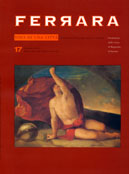Today, there are six magnificent villas on the Varano upland and more than fifty farms in the plain, smaller and of a simpler type, with fewer rooms and larger areas intended for processing or food storage. The largest complexes demonstrate an architectural style enthusiastically wedded to nature: terracing, nymphaeums, flights of stairs and galleries link the various levels of construction. The living areas overlook vast gardens, which, reflected in ponds and pools with water features, formed an integral part of the architecture. Among the wealthy local owners were illustrious families from the capital. Ostentatiousness linked them all.
The abundance of wealth and the enticement of fame beyond the local confines attracted craftsmen of outstanding artistic ability.
Only the Domus Aurea can match the three frescoes depicting Hermes, Minerva and the Planisphere, which come from the ceiling of the upper portico of the majestic Villa San Marco. From the three compositions we reach the spectacular Fall of Phaethon from Helios' chariot: an almost baroque setting for the learned conversations which must once have taken place in the portico with its elegant spiral columns.
Other refinements adorned the villa: precious marble inlay in the floors, marble vases in the gardens.
The chalice-shaped crater from the Villa San Marco rivals in elegance the largest basin, a genuine fountain, found in the garden of the Villa del Pastore, along with the statuette with gave its name to the complex.
The series of paintings from the Villa Arianna were uncovered in the excavations of 1759, and removed from the walls of some of the rooms of the western side of the peristyle, probably from a small women's appartment. A mysterious femininity links Flora, Leda with the swan, Medea and Diana, and the Cupid Seller in strongly Greek taste.
There are also frescos of good quality decorating the reception areas, or the main room (triclinium) and a room next to the entrance, of the villa in Carmiano: bacchanalian scenes adorn the panels in the centre of the three walls of the triclinium, and winged figures and imaginary animals circle on the ochre yellow background of the second room.
A number of fine stuccos come from the baths of the Petraro villa, in a style which reflects the lingering taste of the period of Nero: the lower part of the walls may have been covered with marble slabs, in contrast to the niches, pilaster strips and barrel vaults on which plant decorations and frames delineate narrative panels. The Narcissus reflected in a spring between a column and an Eros holding a dimmed torch in his hands, belonged to the frigidarium; two pugilists confronting each other on a winged griffin, flanked the doors to the calidarium.



